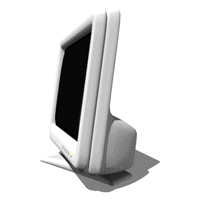Sponsored by BoysStuff.co.uk


Computer monitors may all look the same on the outside, but they vary greatly on the inside. Since it’s what’s inside that creates the image on the monitor, it’s important to learn about the relevant specs before you buy.
Contrast, clarity and overall image quality are the key things to consider. This article will introduce you to these concepts in more detail, and discuss some of the ideal specs.
Computer Monitors – Basic Considerations
At one time, this discussion would have included an overview of the merits of cathode ray tube (CRT) monitors versus LCD. LCD monitors are now the norm so that argument has fallen by the wayside. In addition to the hard numbers about computer monitors, there are some other basic factors for businesspeople to consider.
• Your Office Environment. Do you have a large window that causes a lot of glare on your screen? Is your office dark? Both of these questions will affect your decision on a monitor. To combat glare, you may need to angle your monitor, so you should find one that is adjustable. For dim lighting, be sure the monitor you choose has an adequate brightness rating.
• How You Work. Do you frequently work with several applications at a time? If so, you may want a larger screen so you don’t have to constantly flip between active applications.
Just the Facts – Computer Monitor Specifications
Here are some of the monitor specs you need to know about.
First, there is the response rate. Some tech experts call this number a marketing gimmick. In theory, lower response rates mean less distortion in a moving image. The rate itself is a measure of how long it takes a pixel to go from black to white and back again. While it is probably more important for users who watch a lot of video, this rating can indicate the quality of the image you will see. The “marketing gimmick” aspect is important here. Most manufacturers list the lowest response rate, which is not necessarily the average response rate. Chances are the rate will be higher than the one listed. Response time is measured in milliseconds (ms). If the monitor has specs of 8 to 12 ms or lower, it is usually fine.
Second, is the native resolution. Computer monitors can be adjusted for different resolutions, but the native resolution is the optimal one. Higher resolutions generally mean better image quality.
Third, is the brightness. Brightness ratings indicate how much light the monitor can generate. Brightness is also referred to as luminance. It is measured in candelas per square meter. Most experts will tell you that a rating of about 200-250 cd/m2 is best for work. Higher brightness ratings are okay too, but probably not necessary for a work environment.
Lastly, there is the contrast ratio. This number tells you how bright the whites are and how dark the blacks are. The higher the number, the better the contrast. It used to be that a contrast ratio of 800:1 or 1,000:1 was considered adequate – and it still is - but now even low-priced computer monitors have specs of 5,000:1 or greater.
When shopping, keep in mind that many companies regularly upgrade their computer monitors when something new hits the market. As a result, there are great deals to be had on the secondary market.

| © RIYAN Productions |

